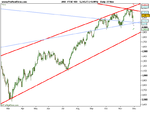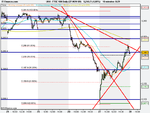Re: Wallstreet1928 Analysis & live calls on FTSE,DAX,S&P...aimed to help New traders
ws.the sta diploma course costs £2350-00p
STA Diploma Course 13 January – 8 April 2010
Preparation for the Diploma examination in April 2009. The Course consists of 11 Wednesday evenings starting on
Wednesday 13 January, followed by a full day Exam Preparation (including Report writing), on Thursday 8 April 2010.
Evening sessions are from 6.00pm to 9.00pm and Exam Preparation Day, which includes lunch, from 9.30am to 5.00pm. The
Exam itself lasts three hours and will be held Thursday 22 April 2010.
The course is expected to cover:
1. Bar charts. Gaps, islands, key reversals. Defining price objectives from gaps and patterns on bar charts. Arithmetic
versus logarithmic scales.
2. Moving averages - arithmetic, weighted, and exponential. Centred, non-centred and advanced. Single, double and
multiple moving average crossovers. Moving envelopes, including Bollinger Bands.
3. Candle charts and candle patterns.
4. Point and figure charts. Construction, scale, box reversal, objective counting. Advantages and disadvantages compared
to other types of chart.
5. Dow Theory.
6. Chart patterns, eg. triangles, flags, pennants, diamonds, broadening patterns (megaphones), wedges.
7. Reversal patterns and how to identify/anticipate them. Rounding tops and bottoms, head and shoulders, spikes,
double/treble/multiple tops and bottoms.
8. Trend. How to draw correct short, medium and long-term trendlines. Trend channels. Return lines and internal
trendlines. Unconventional but useful trendlines. Acceleration. Speed lines. Trend characteristics.
9. Consolidation - how and why it occurs. Breakouts and how to recognise them.
10. Corrections: when and how far.
11. Support and resistance. The various chart points and facets that can act as such.
12. Basic elements of Gann theory.
13. Basic elements of Elliott wave theory.
14. Fibonacci series, fan lines, arcs and time zones.
15. Cycles. Amplitude, length, phase, harmonicity, synchronicity, left and right translation. Detrending.
16. Relative performance and how to interpret relative strength charts.
17. Momentum indicators and oscillators including:
Rate of change - Welles Wilder's RSI - Stochastics (%K & D)
Moving Average Convergence Divergence (MACD) & MACD histogram
Directional Movement Indicator - Parabolics - Commodity Channel Index
18. Volume signals and indicators, including On-Balance Volume, Volume Accumulator etc. Open interest.
19. Breadth indicators.
20. Sentiment indicators and contrary opinion.
21. Market ProfileTM including Construction, TPO, Point of Control, Value Area, Normal Day, Trend Day, Double Distribution
Day, Neutral Day, Non Trend Day.
22. Investor psychology - individual and group.
23. Ichimoku Charts, including Turning Line, Standard Line, Span 1 and Span 2, Lagging Line, Cloud Construction and
Interpretation.
If you wish to register for this course, please complete the application form overleaf and send it to the
address below. Cheques should be made payable to Society of Technical Analysts Ltd.
ws...u are doing youre mentoring too cheaply !!



